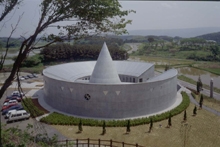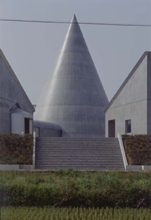

|
Akita , Japan
Design: 1988 - 1988
Construction: 1988 - 1991
Site Area: 6,083.00m²
Building Area: 1,005.15m²
Total Floor Area: 1,005.15m²
Structure: 1 Storey
Reinforced Concrete
Design Concept
The memorial hall commemorating the Shirase Expedition to the South Pole is built in the northern part of Japan where the famous Japanese explorer of the South Pole, Nobu Shirase was born, to acknowledge the accomplishment of Nobu Shirase and his expeditionary party and to preserve and exhibit important informative materials. The purpose of the memorial hall is to leave to the younger generation the history of science and exploration, and to arouse dreams of the future and romance in the younger generation.
The architectural form is composed of a cone-shaped hall 20 meters in height which reinforces its purpose as a memorial hall and an exhibition space in the shape of a ring 50 meters in diameter. The finish of the facade is exposed concrete.
The ring-shaped building includes an entrance hall, exhibition hall, study room, warehouse, and office, and the cone-shaped building is planned as the event hall where exhibitions, symposium and small concerts could be held. The two buildings are connected by a bridge which serves as the axis running north to south. The approach is located at the indented portion on the south side to give understanding to the audience and to impress them with the dramatic form of the building. Controlled by the nuzzles located around the floor of the patio of the building, the water membrane creates various expressions as the floor of the patio which serves as the exterior exhibition space.
The windows of the facade and the slits of the skylight add expression to the exterior of the building, and at the same time, create lighting effects in the entrance hall, lounge and exhibition space. Furthermore, a laser beam may be placed at the top of the cone to express the consensus existing between the history and the future, the individual and the cosmos.
|
|
